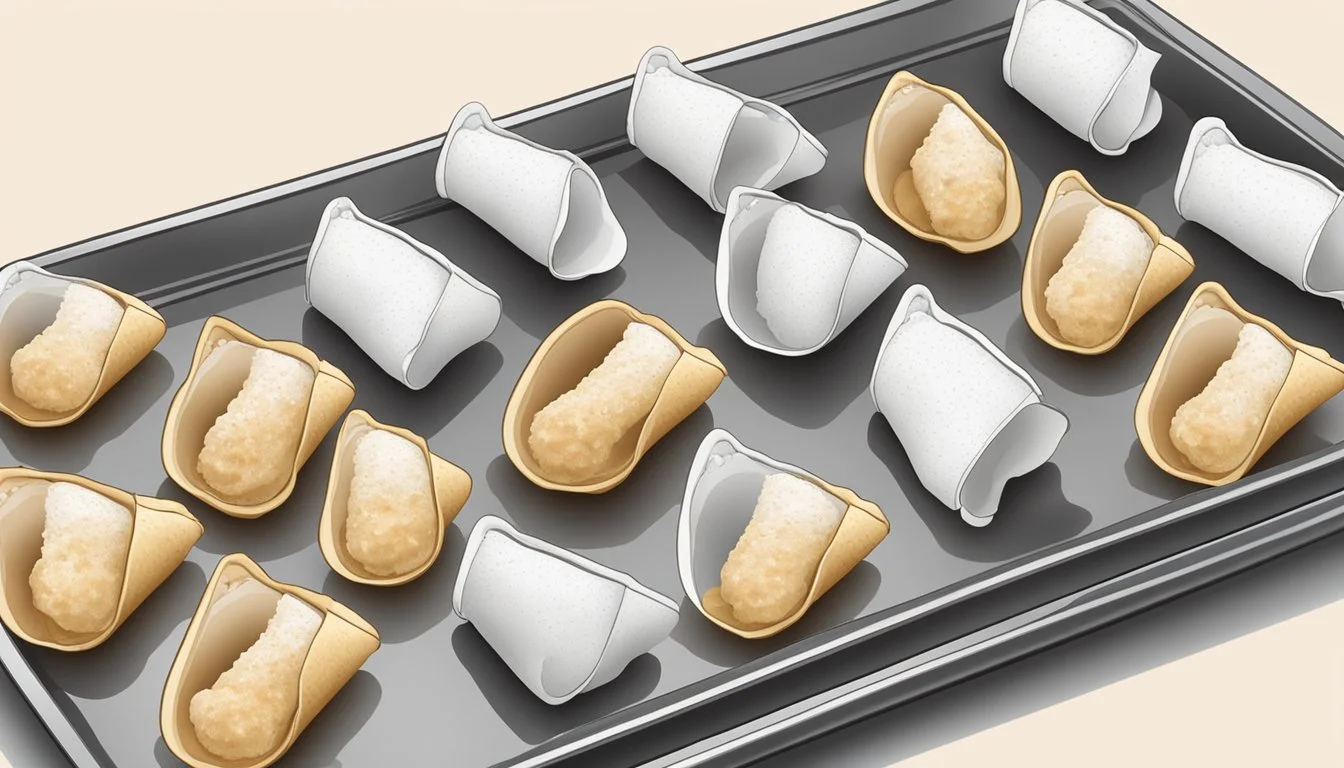Best Way to Reheat Cannoli
Ensuring a Crispy Shell and Creamy Filling
Cannoli, the classic Italian dessert known for its harmonious blend of crunchy shell and smooth filling, presents a delightful challenge when it comes to reheating. The key to rejuvenating this delectable treat lies in maintaining the shell's crispness while ensuring the creamy filling stays rich and luscious. Traditional cannoli shells are crafted from a dough that includes flour, eggs, sugar, and sometimes a touch of marsala wine to achieve the perfect flakiness. Once fried to a golden-brown hue, these shells become the quintessential vessel for the sweet, ricotta-based filling.
The art of reheating cannoli requires a technique that respects the delicate balance of textures. While the filling, a smooth concoction typically made from ricotta cheese and powdered sugar, is ideal when it's cool and creamy, any method of reheating must avoid melting it into a runny state. In an ideal world, cannolis are filled just before serving to maintain the integrity of both components. However, when faced with the need to revive leftover cannoli or to serve a pre-filled dessert at its best, certain strategies can help achieve a result that closely mirrors the original experience.
Understanding Cannoli
The iconic Italian dessert, cannoli, involves crisp pastry shells filled with a sweet, creamy mixture, often containing ricotta. Mastery of the cannoli's contrasting textures is key to its culinary delight.
History of Cannoli
Originating from Sicily, cannoli are steeped in Italian tradition, rooted in historical festivals like Carnival. Often thought to symbolize fertility and abundance, Sicilian cannoli have maintained their status in Italian cuisine for centuries, evolving in flavor but retaining their classic form.
Components of a Cannoli
A cannoli is composed of two primary elements:
The Shell: Typically made from a dough containing flour, sugar, and Marsala wine, the shell is rolled thin, wrapped around a metal tube, and deep-fried to achieve a golden, crisp exterior.
The Filling: The creamy filling is traditionally made of ricotta cheese, sweetened with sugar and often enhanced with ingredients like chocolate, pistachios, lemon zest, or candied orange peel.
It's important that these components balance each other, with the shell providing a crunchy counterpoint to the rich, creamy filling.
Homemade vs Store-Bought
Homemade Cannoli Store-Bought Cannoli Shell Can be made fresh, allowing for customization of flavor, size, and thickness. Pre-made and typically uniform in size and taste. Filling Filling can be prepared with fresh ricotta and customized with various mixins like fresh lemon zest or chocolate. Can vary in quality, with some lacking the richness of fresh cream and ricotta cheese. Experience Offers a personal touch and often a fresher, more authentic taste. Convenient but may sacrifice some flavor and texture for shelf stability.
Enthusiasts often argue that nothing beats a homemade cannoli, particularly when it comes to the quality of the ricotta filling and the crispiness of the freshly fried shells. However, store-bought cannoli can provide a quick and convenient option for those unable to craft their own at home.
Storing Cannoli Shells
Proper storage of cannoli shells is vital to preserve their crispness and prevent them from becoming stale. A clear understanding of the optimal storage conditions and methods for preventing stale shells ensures the best quality for later use.
Optimal Storage Conditions
To maintain the quality of cannoli shells, one should store them in a cool and dry place, away from any sources of heat or moisture. The ideal storage temperature is at room temperature, which significantly assists in keeping the shells crisp. Exposure to air and moisture is a shell's nemesis; therefore, the use of an airtight container is paramount. For those who seek to extend the shelf life further, placing the carefully wrapped shells in a plastic container in the freezer can keep them for a few weeks.
Temperature: Room temperature.
Environment: Cool, dry place.
Container: Airtight.
Preventing Stale Shells
The battle against staleness in cannoli shells is won by minimizing their exposure to air. Sealing the shells in plastic wrap before placing them in plastic containers adds an additional layer of protection. However, one must ensure the shells are completely cool before storing to avoid condensation which could soften the shells.
Wrap: Seal in plastic wrap prior to container storage.
Cool Off: Allow to cool completely before sealing to prevent moisture buildup.
Airtight Containers: Use containers with secure seals to lock out air.
By adhering to these guidelines, one can consistently enjoy cannoli with the intended textural contrast of a crispy shell filled with creamy ricotta.
Maintaining Cannoli Freshness
The freshness of a cannoli depends on proper filling and sealing techniques, understanding the shelf life, and adequately freezing and thawing.
Filling and Sealing Techniques
When preparing cannoli, the timing of filling is crucial for maintaining freshness. Shells should be filled as close to serving time as possible to avoid sogginess. For the best texture, use a creamy, rich ricotta filling and ensure that it is chilled. After filling cannoli, the ends can be dipped in chocolate to create a seal that slightly prolongs freshness.
Understanding Shelf Life
Cannoli freshness is significantly influenced by shelf life. Unfilled cannoli shells can be stored at room temperature for up to two weeks when kept in an airtight container. Once filled, cannoli should be consumed within 1-2 days when stored in the fridge to maintain the ideal taste and texture. It is essential to keep them away from strong-smelling foods to prevent the ricotta filling from absorbing unwanted flavors.
Freezing and Thawing Cannoli
To extend the shelf life of unfilled cannoli shells, freezing is a viable option. To freeze, place the shells in a hard, airtight container to prevent crushing. Label with the freezing date, since shells typically last a few weeks in the freezer. For thawing, let the cannoli shells come to room temperature inside the container to prevent condensation before filling. Avoid freezing filled cannoli as it may compromise the creamy texture of the ricotta filling.
Best Practices for Reheating Cannoli
To ensure cannoli shells maintain their crispness and the filling its creaminess upon reheating, one must follow specific strategies tailored for these delicate Italian pastries.
Reheating to Retain Crispy Texture
Temperature control: When reheating cannoli shells, preheat the oven to 350°F (175°C).
Timeliness: Bake the shells on a baking sheet for approximately 5-10 minutes.
Monitoring: Keep an eye on the shells to prevent over-browning, which can lead to an undesired hardness.
Avoiding Soggy Shells
Handling moisture: To combat sogginess, ensure all shells are at room temperature before reheating to avoid condensation build-up.
Container choice: Store cannoli shells in an airtight and hard container to protect against excess moisture and crushing.
Reheating Filled Cannoli
Separation tactic: Ideally, one should store the filling and the shells separately. Reheat the shells alone and fill them with the creamy mixture just before serving.
Filled reheating: If filled cannoli must be reheated, it's best to do so at a low temperature (275°F or 135°C) for a shorter duration to warm the filling without melting or causing the chocolate to seep into the shell.
Serving and Presentation Tips
Presenting cannolis in their best form involves attention to both taste and aesthetics. A well-warmed cannoli offers a delightful contrast between its crunchy shell and smooth, creamy filling, enhancing the overall experience.
Adding the Final Touches
To ensure cannolis make a statement, one should dust them with powdered sugar just before serving. This not only adds a visual appeal but also a subtle sweetness. For those who prefer a hint of chocolate, a light drizzle of melted chocolate can be both visually pleasing and flavor-enhancing. To maintain the integrity of the shell's crispiness, these toppings should be applied after reheating and just before the cannolis are presented to the guests.
Pairings and Accompaniments
A well-matched accompaniment can elevate the cannoli experience. A side of pistachios adds texture and a contrasting flavor that complements the sweetness of the cannoli cream. For beverages, a glass of Marsala wine—the same sweet wine often used in the pastry dough—is an excellent choice, enhancing the flavor profile of the dessert. Here's a simple table to summarize the pairings:
Accompaniments Description Pistachios Adds a crunchy texture and nutty flavor that complements the creaminess of the filling. Marsala Wine Enhances the sweet and nuanced flavors within the cannoli shell and filling.
Remember, the key to an exceptional serving and presentation lies in the details. Create a visually appealing plate, and match the flavors thoughtfully to ensure every bite is memorable.







